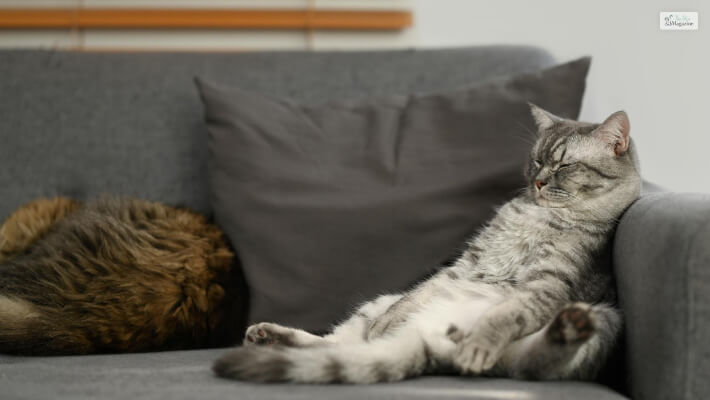Cat Twitching In Sleep: When To Worry And What To Do


Do you know cats usually sleep 12 to 18 hours daily? Jealous yet? I am. Cats usually sleep for almost half to three-quarters of the whole day. They usually spend half their lives sleeping.
If you are a cat owner, then you might have seen that when these furry little babies are sleeping, they usually twitch. For most, these slight twitching and turning might seem very cute and cuddly, but for rest, it might seem concerning.
Stages Of A Cat’s Sleep
A cat’s sleep acts as a recharging factor for them; it helps them maintain their immune system and their overall well-being. There are usually three to four stages in an adult cat and kitten, respectively.
1. Catnaps

Catnaps are usually very light and short in nature. During this sleep stage, the cat, although sleeping, are aware of its surroundings. While you might think that your cat is sleeping, its defence system is on point and will attack if they sense any danger.
Using catnaps as a defence mechanism is primarily used by wild cats, but these tendencies are passed on to domesticated cats as well.
2. Light Sleep

The stage of light sleep lies somewhere between catnaps and deep sleep. The awareness level cat’s during this stage, the cat is still able to attack if it senses danger. The average time it lapses during light sleep is about 25 minutes.
3. Deep Sleep

Deep sleep, or what is normally called REM sleep (Rapid Eye Movement), is a stage that lies between light and deep sleep. But it is a shame that this stage only lasts for about 10 minutes, but the cat twitching in sleep happens in this stage as well.
But why do cats twitch in their sleep? The twitching happens when the cat is likely to be dreaming; when this happens, the cat becomes hard to wake up. If you want to make that experience more pleasurable for your cat, then make the perfect bedding for your cat.
Set up a bed or even a padded raised area for your cat to sleep. To provide a more comfortable REM sleep experience for your cat, remove any other stimulus from the surrounding, like kids and other animals.
It should be noted that the bedding area should be kept in a cooler area to make it more comfortable for your cat. The room shouldn’t be too cold, as the cat might roll up to sleep and might feel uncomfortable. Cats usually sleep more comfortably in warm temperatures.
4. Activated Sleep

Kittens achieve this fourth stage of the sleep cycle, not usually by adult cats. This is when the kitten activates the nervous system and is at rest during sleep. This is the stage when the kitten squirm, cries and twitch more than the average time.
Just like any other nerve firing in smaller animals, this helps to develop their nervous system. So it is very important that you never wake a sleeping kitten up. It is important that these kittens need a lot of rest and sleep to develop their nervous system and gain energy while sleeping.
What is Feline Hyperesthesia Syndrome?
It is still a matter of debate among experts and vets about the effects of Feline Hyperesthesia Syndrome and what it means. Hyperesthesia is a triggering syndrome in cats that occurs from doorbells, touching sensitive body parts of cats, and changing litter and food.
Some people believe it is a mental problem that can cause seizures and obsessive-compulsive disorder.
Feline Hyperesthesia Syndrome Symptoms You Need To Know
Feline Hyperesthesia Syndrome has different effects on different cats, and it happens in bizarre times. The intensity and erratic nature are also different in different cats.
The erratic behaviour also includes:
- Furious tail-licking
- Agitated demeanour
- Frantic leg, back and tail licking
- Running the zoomies (super duper fast)
- Acting all “possessed”
- Biting its tail, back and legs
The Feline Hyperesthesia Syndrome has a few symptoms such as:
- Fast Breathing
- Unusual vocal noises
- Pupil dilation
- Increase in saliva
- Ripping the fur and skin from its back
Why Is My Cat Twitching In His Sleep?

It is not difficult to notice that my cat is twitching in his sleep, but why is that happening? Although the chances of him dreaming in his sleep is quite possible, there are other chances as well. Twitching and turning in your sleep while dreaming is quite possible.
The process of REM sleep and the stage of dreaming can occur only in a matter of 25 minutes.
During the stage of dreaming, the effects are,
- Paws moving
- Meowing
- Twitching ears, nose, and whiskers
- The mouth is moving even though silent meowing
Cat twitching causes
There are various possible causes behind a cat twitching as they sleep. Let’s check what those are:
Dreams
Just like we humans go through Rapid eye movements (REM), cats do as well. There are phases of REM and non-REM cycles while they are sleeping. Cats have similar brain activity to humans, so they might also dream during the REM phase.
They can have mild twitches while they are in the REM phase, which could be related to their dreams. But small twitches of the tail, face, ears, and legs are common and nothing to worry about. But if this is something non-related to dreams, then this could be a cause for concern.
Allergies
If you find your cat twitching during their sleep and they suddenly wake up and start grooming themselves, they could mean that there is something on their skin that is bothering them. It might be fleas, skin infections, matted fur, or allergies. It is important that you check your cat for fleas regularly and keep their coat clean.
If you find your cat itching their ears, it might be because they have developed some kind of ear infection or have ear mites. Ear infections and ear mites create a type of waxy debris in their ears, so check their ears regularly.
Seizures
Cats who get seizures show signs like shaking, tremors, twitching, and spasms. Seizures often affect brain activities like waking up or falling asleep. their limbs might get rigid, or they might also lose control of their bladder or bowels. If you think your cat is having a seizure, take them to a vet immediately.
Muscle spasm
Muscle spasms in cats also look like twitches. Actual spasms are a lot worse than a few flicks and kicks that a cat does while they are sleeping. Toxins like permethrins are responsible for causing spasms. These are difficult to differentiate, so the best you can do is take a video and show it to your vet.
Is My Cat Twitching In Sleep Or Having A Seizure?

If you are trying to wake up a cat twitching in sleep, but is constantly failing, then it could be the case that my cat is twitching in sleep and is actually having a seizure. In such a case, you need to immediately consult and contact your vet.
When a cat is having a seizure, the twitching becomes twitchier with a jerky movement. But when he is dreaming, the twitching is calmer.
To rule out seizure, you should keep a close eye on your cat when it is twitching.
- Muscles stiffening on the limbs
- Difficulty in waking it up
- Jerky moving
- Changed eating habits
- Exhaustion and fatigue
- A foamy and liquidy substance around the mouth
Wrapping Up!
It is always a fact to remember that a cat twitching in sleep is not a matter of concern and is not harmful. As a matter of fact, a twitchy little cat or kitten can be quite entertaining and very cute.
Although you might feel jealous of your cat sleeping most of the day, it is quite important for the cat to grow and develop. If you are an expert cat owner, then it is quite possible that you know not every twitchiness of the cat is not something harmful and a matter of grave concern.
If you have any more queries or concerns regarding your cat twitching in sleep, then you can ask your question in the comment section down below.
Read Also:








All Comments
Benito Curbeam
28 July, 2023
I need to to thank you for this fantastic read!! I definitely enjoyed every bit of it. I've got you bookmarked to look at new things you post…
Reply